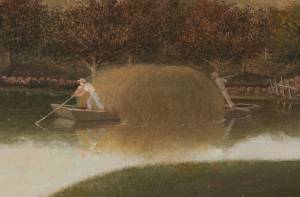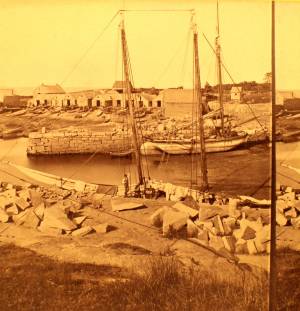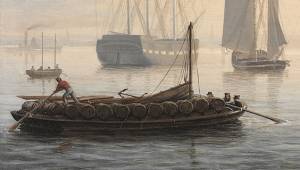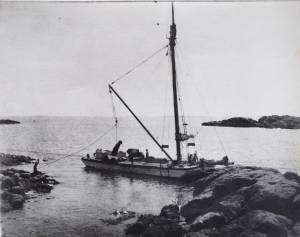An online project under the direction of the CAPE ANN MUSEUM
Gundalow / Scow
View related Fitz Henry Lane catalog entries (4) »
The rivers of northern New England gave rise to a type of freighting scow called a "gundalow," having square ends, a flat bottom, shallow draft, and sturdy construction going beyond the usual standards for this hull type. The term “gundalow”—variously spelled and pronounced—was first used in the late seventeenth century in New England, and was derived from the Old World term “gondola”—also a flat-bottom vessel, but more varied in hull form and uses. (1)
The rivers and estuaries of Essex County, Massachusetts were subject to tidal variations and their surrounding lowlands were salt marshes which yielded prodigious quantities of grass. The more succulent varieties, called “marsh hay” were valued fodder for livestock, while “thatch,” which grew along the tidal creeks, was used for roofing of buildings, bedding for livestock, and compost for gardens. Grasses on higher elevations could be carted away after cutting, but at lower elevations, it was the job of gundalows to bring it to a landing for distribution. Gundalows for these tasks were relatively small, less than 40 feet in length, propelled by long oars called “sweeps,” and by poles. Occasionally a single square sail was set from a short mast if the landing was distant and downwind. (2)
Larger gundalows, of more elaborate construction, were to be found on the Merrimac and Piscataqua Rivers of Northern Massachusetts and the Maine–New Hampshire boundary, respectively. The Merrimac gundalows probably reached 45–50 feet in length, had long overhangs with a stem post, a skeg with rudder and tiller, heavy framing, and a mast stepped well forward from which a square sail could be set when going downwind. (3)
Not just confined to the Merrimac River, many of these vessels found their ways to the Ipswich marshes via a canal on the mainland side of Plum Island. Smaller and simpler versions of this type were built to work in the salt marshes of Essex and West Gloucester, dispensing with sails and propelled much of the time by poling through narrow tidal creeks. (4)
Lane took notice of a gundalow in his painting Babson and Ellery Houses, Gloucester, 1863 (inv. 10) and the remains of another in his Looking up Squam River from Done Fudging, 1850s (inv. 26). In both cases, the hulls are small and simple in detail, but the latter shows part of its heavy inboard construction. Gundalows of this variety survived in Cape Ann estuaries long enough to be photographed.
Piscataqua River gundalows were the largest and most highly developed of this vessel type, measuring 65 feet or more and rigged with a lateen sail set on a very short mast. When sailing under a bridge, the sail could be dipped without lowering and quickly reset once clear. The hull was modeled with a rounded bow and finely shaped stern; many were fitted with a leeboard so the vessel could sail upwind on the broader reaches of the Piscataqua. (5)
Lane’s depiction of a gundalow in Boston Harbor in the mid-1840s is of the type associated with the Piscataqua River, but having features of both earlier and later examples, together with a rig not known to be used on these craft. The “spoon bow” has generally been regarded as a post-1860 feature, yet Lane’s example has one. The stern has a finely modeled transom which is clearly seen in the underdrawing revealed by infrared scanning. Rudders were supposed to be fitted by the early 1800s, but Lane’s example is steered with an oar. The graceful sheer is another feature considered to post-date Lane’s painting. Finally, the rig consists of a gaff- headed sail set from a very short mast. Short fixed masts setting large lateen sails were common to late gundalows, but the gaff rig depicted is so small that its usefulness is limited if not questionable (6).
Close examination of the infrared scans of this image shows careful drafting of the hull and re-drawing of the crew, sweeps, and steering oar. The cargo of casks is also extensively redrawn to show correct stowage. Whether the changes were due to criticisms from others or the artist’s own evaluation is probably lost to history.
– Erik Ronnberg
References:
1. M.H. Parry et al., Aak to Zumbra: The World's Watercraft, (Newport News, VA: The Mariners' Museum, 2000), 264.
2. Ibid.; and Nancy V. Weare, Plum Island: The Way It Was, 2nd ed. (Newbury, MA: Newburyport Press, Inc., 1996), 43–48.
3. D. Foster Taylor, "The Piscataqua River Gundalow," The American Neptune II, no. 2 (April 1942): 127–39.
4. Weare, 43–48.
5. Taylor, 127–39.
6. Ibid.; and author's observations.
Related tables: Annisquam River » // Salt Marsh Hay / English Hay » // Town / Public Landings »
4 x 5 in.
Cape Ann Museum Library & Archive
#10159
Rare view of a marsh gundalow, being used on the Annisquam River for harvesting salt marsh hay.
Also filed under: Annisquam River »
Stereograph
Cape Ann Museum Library & Archive
Also filed under: Granite Quarrying / Shipping »
Photograph
Private collection
Granite scow being unloaded at Knowlton's Point, Sandy Bay. Sandy Bay Ledge visible in right background, Dodge's Rock in left background.
Also filed under: Granite Quarrying / Shipping »




